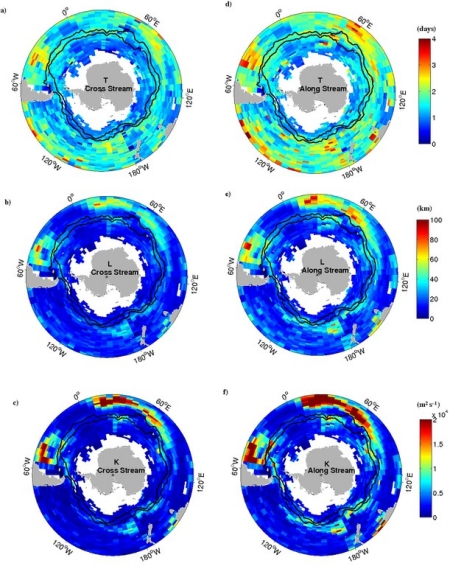Southern Ocean Eddy Diffusion
A new lateral surface eddy diffusion coefficient has been calculated from surface drifters and altimetric data.
A statistical analysis of surface drifter observations is used to compute eddy length and time scales and lateral eddy diffusion in the Southern Ocean.
Lateral eddy diffusion values of the order of 104 m².s-1 are found in the energetic western boundary currents north of the Antarctic Circumpolar Current (ACC) and secondary peaks show up where the ACC negotiates topography. The diffusivity shows an increase from the Antarctic continent to the ACC, a stable plateau within the ACC and either a decrease North of the ACC outside the western boundary region or further increase dominated by the western boundary currents.
Diffusivity is also calculated from simulated trajectories based on altimetric geostrophic velocities, with and without mean flow, as well as with simulated trajectories based on Ekman currents. Ekman currents at the drogue depth (15m) have only a small impact whereas the geostrophic currents dominate the eddy diffusivity. The mean flow acts as a weak barrier to mixing oustside the western boundary regions and tends to reduce the along stream eddy diffusion. Complementary statistical analyses confirm these results.
The surface drifter eddy diffusion is used to test a simple parameterization based on satellite altimetric observations of eddy kinetic energy (EKE). For EKE ≥ 150 cm².s-², the eddy diffusion = 1.35√EKELd m.s-1, where Ld is the first baroclinic Rossby radius. This parameterization holds in the energetic ACC, consistent with an eddy field in the “frozen field” regime, and fails over broader areas of weak eddy fields, where mixing is nevertheless fairly uniform and stable at about 1800 +/- 1000 m2.s-1.
Further information on the method and access to the eddy diffusion coefficient matrix.
References:
- Sallée, J.B.; Speer, K.; Morrow, R. and Lumpkin, R. (2008). An estimate of Lagragian eddy statistics and diffusion in the mixed layer of the Southern Ocean, Journ. of Marine Res., 2008, 66(4), 441-463





